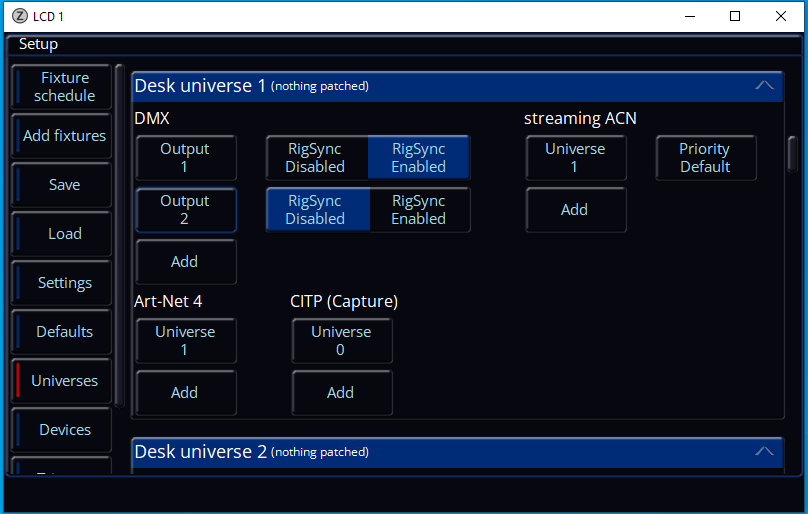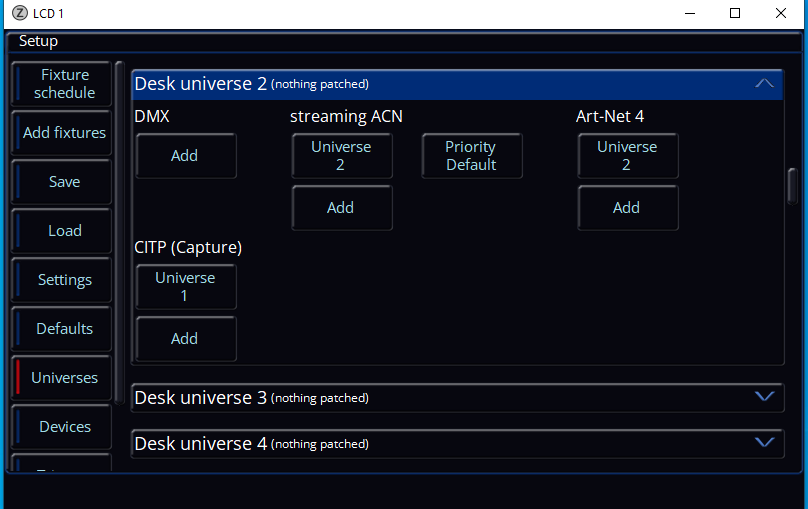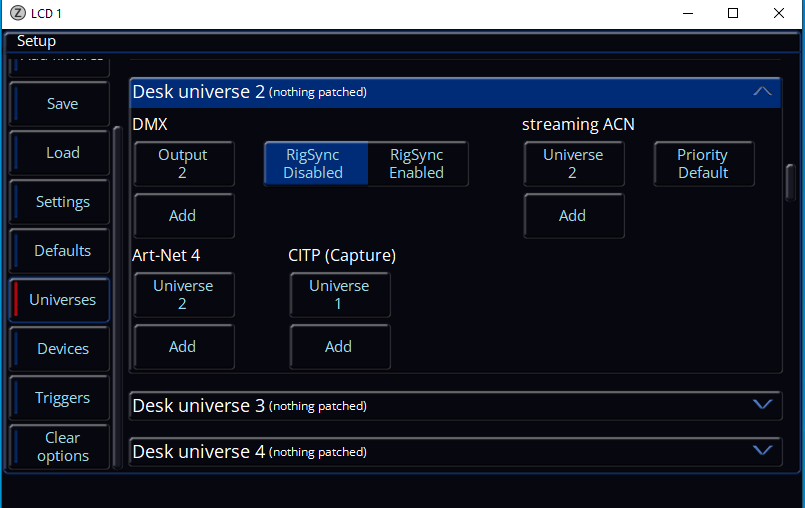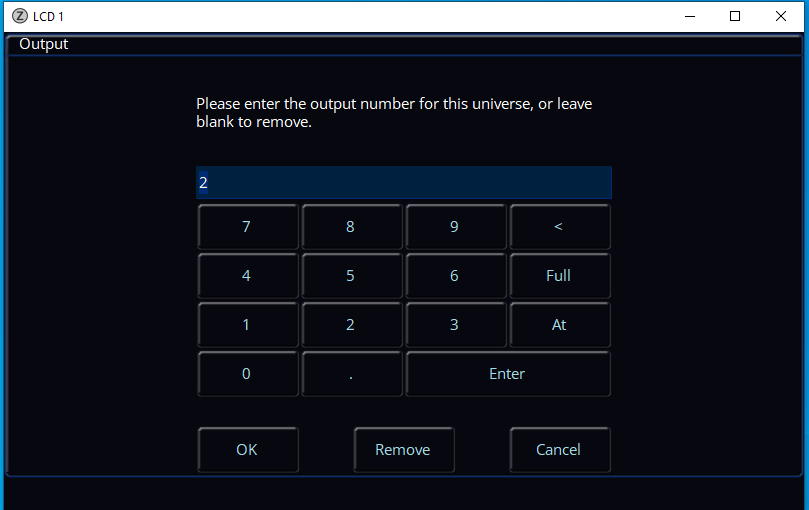-
Posts
2,066 -
Joined
-
Last visited
-
Days Won
107
Everything posted by kgallen
-
Maybe we should start a "Hot Tips" thread... I will certainly be downloading that Grease zos after my show is done, but this is just because I'm nosey to look at a "professional" showfile. I think what lots of us are missing is the workflow and the totally in depth knowledge and the tricks and sneaks that get you out of a mess, which can't be gained just by looking at the end result (the showfile). I'm not a novice on FLX. but I lack that confidence that comes from knowing the console inside and out that comes from working with it for many hours a month, which is something I don't do as an amateur. Edward, if you have a related Capture project would you be prepared to upload that too?
-
Have you patched the console to the same fixture mode as the mode actually set on the fixture? Complex fixtures often have a range of channel count modes, sounds like you might have patched a low channel count mode on the FLX S different to that on the actual fixture. Sorry if you already know this stuff, no insult intended! The other thing you could try just to confirm the fixture operates is to patch 22 (or whatever) dimmer 1-channel dimmer fixtures at the base address of your mover and then using the faders, ensure each causes the fixture to behave in the way you expect from the DMX map in the fixture documentation. Also in the fixture patch screen in setup you should be able to see a list of what each channel does on that fixture, to make sure you can see channels 22 up have the correct fixture parameters associated with each - there is a chance (although slim) that the fixture definition has an error in it. If you can, upload the showfile here in case Z88 folk need to help you out further...
-
@scottydog75 @Uriahdemon What we need is an FLX Advanced Training Course with a decent sized rig. We could club together and hire @Edward Z88 for the day. Then we can show him how bad we are - but also the "challenges" we have through weak console knowledge... or also where the console makes our workflow a bit clunky...
-
I don't know the internals of this desk but I suspect you're looking for some chip numbers that start 74. Maybe something like 74xx138 (where xx are likely to be some letters like LS or ALS or HC or HCT for example).
-
Yea Edward, but you're some kind of super-human lighting programmer that works with the FLX 8 hours plus a day every day, and know the thing inside better than we know the outside! 🥰
-
At which point I'll note (what we all find) is that we "fall foul" of SmartTag which won't record a fixture at 0%. I had exactly this issue with "Fire" which was far too bright for me at the default Effect level, since I wanted just a background firelight flicker not an all-out inferno. For the cue and the "Effect Off" I ended up using 1%, just because I couldn't be faffed during a pressured tech rehearsal to faff about with Updating the cue with SmartTag off. But I only just got away with 1% with LED fixtures... With Effect and particularly "No Effect", SmartTag does us a disservice here and makes the programming more clunky rather than easy, which is what SmartTag does in just about all other cases. The other "pain point" for SmartTag being Remove. I know this suggestion is horrible, but it feels like these few point cases could/should be an exception to SmartTag's usual rules... which I hate to suggest because I generally hate inconsistencies, but the behaviour is a hindrance rather than a help in these situations. Yus' sayin'...
-
Record a new Effect palette with those settings then use that Effect palette in your cue. I think I've had issues in the past with setting an Effect and when recorded directly into the cue it doesn't work as expected. I think advice was to create a new Effect palette first then use that.
-
Don't know why I'm attempting to explain as I'm sure Edward will be along soon with a proper answer! I think this is because the effect swings around 50 as the midpoint. At "full size" the swing will be 0-100 (50 +/-50), at a smaller size the swing will be say 30-70 (i.e. 50 +/-20). I was using the Fire flicker in plotting over the weekend and also struggled a bit to get a low intensity (in my case) but retain a decent amount of colour modulation. As we know for now, size affects the swing of the intensity and whatever other parameters are modulated by the effect. Can you set "Fader controls: Effect" I can't remember...
-
I have similar worries on occasion and I'm a relatively experienced FLX user. DELETE can be used in some pre-fix and some post-fix scenarios but since they are not universal I can understand there is some "ambiguity" where there isn't a button that can be used as a qualifier. Where I can I'll use a qualifier, DELETE GROUP 1 for example. On the fixture schedule I'll select first, 1 THRU 4 DELETE. Similar applies to cues in a playback which I believe (key to your question) is view-context sensitive. DELETE <playback button> is usually a certain way to delete a whole playback as is DELETE <UDK>. I have asked for some time for the messaging to be improved - to be more specific about what is going to be deleted, otherwise the confirmation screen is pointless in providing a usable "are you sure" check. This is relevant in a number of DELETE scenarios. As yet this hasn't been forthcoming. I thought the manual was fairly comprehensive on this topic (and clearly I'm not always comfortable with every scenario), but I'm sure Edward will read this thread and re-read the manual section to ensure it's clear, particularly in the areas you highlight. In that respect if there are other scenarios that give you butterflies then I'd capture them in this thread for Edward to review the documentation. Having looked, what is evident of course that because DELETE can be used in so many contexts, it's not documented in its entirety in one section of the manual. It's documented in the section according to what is being deleted. https://www.zero88.com/manuals/zeros/cues-playbacks/deleting https://www.zero88.com/manuals/zeros/groups/deleting-groups https://www.zero88.com/manuals/zeros/patching/fixture-schedule/deleting-fixtures https://www.zero88.com/manuals/zeros/palettes/deleting-palettes https://www.zero88.com/manuals/zeros/patching/fixture-schedule/syntax
-
1) Yes you can "Add" multiple dimmer addresses to a console channel. You'll have to fiddle about with your patch console channel numbers to close up the gaps from the multiple patching assuming you start with a 1:1 patch of the 48 dimmers. See "Add as additional" on this page: https://www.zero88.com/manuals/zeros/patching/fixture-schedule/edit-dmx-address 2) I don't know if your model of Spice supports RDM, you'll have to look up the datasheet, or Z88 folk will answer shortly... Looking at the datasheet I don't think Spice supports RDM: https://www.vari-lite.com/global/products/spice#_english
-

Select, save just one feature ("slicing" a show)
kgallen replied to discover's topic in FLX S24 & FLX S48
Tracking on SmartTag on (usually) Just change the one thing and record. If that one thing isn't intensity but the intensity relating to the one thing is zero then you will need to turn off SmartTag in order to record the one thing. When programming, groups are usually essential if you are wanting to select multiple fixtures. Running the show, then ensure the playback buttons of your "CUE x" are set to GO. Sounds like you want to do similar to this Manual section, but also want to do similar with position, beam and shape. Same approach as for colour in this: https://www.zero88.com/manuals/zeros/cues-playbacks/playing-back-cues/rgb-colour-mixing-on-playbacks The one thing you never want to do when working this way is to be in Cue Only or record with snapshot. Better answers incoming from the Z88 folk... -
You will have to remove Output 2 from Universe 2 first. Then use Add in Universe 1 to add Output 2. In fact the limitation is on number of DMX addresses so if you have a 1 universe console you have a 512 DMX address limit and you could spread those anywhere across 64 universes (silly I realise). So you could use Output 1 with Universe 1 and Output 2 with Universe 2 if you wanted so long as you didn't have more than 512 DMX addresses patched across both Universes. What you want to do is usually what I do - 1 universe output over two connectors - 1 output to the dimmers and 1 output to the DMX chain around the LED fixtures. After a desk reset, Universe 2 will have Output 2 assigned: Click on "Output 2". Then click Remove on this screen: Universe 2 will end up looking like this: In Universe 1, click Add then type 2 to add Output 2 to Universe 1:
-
That's the baby 😁 (My browser says it unsafe though 🤣) You should https that page and add it to the Forum banner too!!!
-
It's magic when you know! https://www.vari-lite.com/global/products/leap-frog-series#_spareparts That extra level of indirection via Vari-lite doesn't help dig down to this info. Prior to the merger I think we finally got the "new" Zero88 website to a workable structure where both new and legacy Zero88 products could be found very quickly from the A-Z Products pages, and wham you were straight into the pages that gave you all that info. I guess we've now lost all of that with Vari-lite and the focus is back on new sales products. I hope we can claw back that legacy support data in an accessible form and that tag-line "...and yes we still support them all". (I searched "zero wire" as a stress-test example and did indeed get to a page, so that is a relief!)
-
Absolutely, and we'd be lost without them 🥰 But the Vari-lite site doesn't really help you get to them... (well yes I know there is a page of bland "contact" details but ye know it's a bit detached from what there was on the original Zero88 site, which unfortunately now just takes you back to that same Vari-lite page!). I'll just keep nudging Jon and Edward to get the Vari-lite "masters" knocked into touch although I'm sure they feel equally frustrated!
-
They don’t list it but might also be worth a phone call to Thomann. Also worth filling in your Forum Profile https://www.zero88.com/forum/profile/13680-renato/ - I had no way to know you were in Italy which is information I could have used to search a bit closer to home for you. 👍
-
Upload your showfile. Lots of things could have gone wrong in your programming - sounds like you maybe didn't record what you expected to, and then when you lowered the fader, it released the lights and the fader, once pushed up again, didn't have the programming in you thought maybe?
-
Hi. Did I not answer this here already an hour before this double post?
-
I'll note here for the Zero88 folk that trying to find spare parts and similar hardware support on the Vari-lite pages is fruitless if you are outside of North America (US/Canada/Mexico). There is no selection for Europe/UK/Asia and the "old" links on the Zero88 website don't work for spare parts or European/UK distributors etc (or at least those I found on the Blue Room [e.g. https://www.blue-room.org.uk/topic/61134-zero-88-fat-frog-psu/?do=findComment&comment=497542] or this forum). Searching the Zero88 site for "PSU" or "spare" comes up with nothing or takes you to the Vari-lite page for distributors which suffers the geographical limitations stated above. At this point Zero88 support for the common man outside of Vari-lite's traditional NA territory has just disappeared. If you're "in the know" you know where to turn, but the Vari-lite website doesn't do that for the general populous of non-NA Zero88 users. Maybe there is a route through the Vari-lite website, but as a "casual user" I couldn't find it. Can this be addressed? Finally google found me a page (no idea how I'd get there otherwise, and going back "out" to the Vari-lite main webpage, I can't see how I'd get back here): https://www.vari-lite.com/global/products/frog-series#_spareparts For the OP - the official part number is thus: 5537500
-
If @KWR88 can't help, then I found these options: https://www.10outof10.co.uk/acatalog/Zero-88-Universal-PSU-p-n-5537500-12608.html#SID=188 https://stagegearstore.co.uk/zero-88-55-375-00-power-supply-xlr-4-pin-frog-jester-juggler.html?utm_source=Adible&utm_medium=Free-Listings&utm_campaign=Surfaces&gclid=CjwKCAjw36GjBhAkEiwAKwIWyXl1v-VTMk6yFM1xJOLGLQL3OyRgD1UIxEt1fVLIo8qscymZb5JlwBoCiNYQAvD_BwE https://ultralightsound.co.uk/product/replacement-power-supplies-for-zero-88-desks/
-
It's probable Keith will map your fixtures over to the latest library fixtures. When you upgrade ZerOS and load this new showfile, I would advise flicking though your cue list live and checking that you get the expected results. Fixture manufacturers aren't always great at keeping their documentation up to date, and fixture firmware moves on. So there is the slight chance there is a difference to what you have hung (although in my experience they are usually inconsequential). But you want to find that out at a time not in the middle of a show!
-
Welcome! Yes the fixture information and the patch will be saved in the showfile. However you are a very long way behind on ZerOS versions - lots of things have changed since 7.9.2.60 (which sounds like the ZerOS version the desk came installed with) particularly with regard to colour emitter support in fixtures. Having said that, the user interface doesn't look much different overall so you won't be faced with a console you don't recognise! Latest ZerOS is 7.13.
-
So if nothing works in the rear USB ports then @KWR88 is your man. Can you test your touchscreen on another device like a windows 10 machine since you say it doesn’t work in any usb port on the console. Is it possible the monitor got damaged in any way and it doesn’t work and it took out the usb on the FLX S? Does the monitor have any thru USB ports and if so can you see if those thru usb ports work with a known working usb device - from the FLX S and a Win 10 machine - even though we ‘know’ the touch on the monitor doesn’t work. Keith will need this info even if I can’t help you any further.
-
Thank you! Being picky... https://www.zero88.com/manuals/zeros/selection-and-intensity/intensity-wheel "eg each fixture will increase or decrease by a percentage from its original value" vs https://www.zero88.com/manuals/zeros/selection-and-intensity/commands#scaling "they can also be taken to a defined percentage of the level they're currently at" As you've explained they are different, so I'm not sure you should be using "percentage" in a comparable context in each section. I think the first one needs to change, something like (but better than) "decrease by the same [absolute] number of points from its original value" (I know you won't want to use [absolute]). The use of percentage in the syntax page is also slightly corrupt since in this context you mean "mathematical scaling" rather than percentage in the way we use for intensity 0% to 100% (which unfortunately is exactly what you do mean in the wheel context! ).
-
Thanks Jon. I concur with both. I like it (quite a lot...). I just hadn't appreciated the difference and the manual "relative" and "scaling" didn't clarify that for me (in a clear enough way for my old brain at least!).







